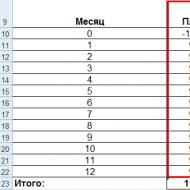
How to calculate a loan yourself: a calculation formula on a calculator
"Wow! If in order to get a loan, you have to mess around with such formulas, then it’s better not to take it at all! It's a whole binomial of Newton!"- this is how the hero of our today's article, Andrey, reacted to the formulas for calculating loan parameters.
How is credit calculated?
There are special formulas, there are several of them, and they are interconnected. Before proceeding to them, it is necessary to define the basic concepts. Some are intuitively obvious, especially since you set them yourself:
- sum loan (SmZ);
- term(TermM - period in months) for which the loan is given.
With an annual interest rate(PrcSt) is also more or less clear, because you will have to pay for the provision of money.
used in calculations as monthly interest rate (PrcStMes), and daytime(PrcStDn). They are calculated as fractions of a whole, not as a percentage:
PrtsStMes = PrtsSt / 12 / 100;
PrtsStDn \u003d PrtsSt / 365 / 100 or PrtsSt / 366 / 100 if the year is a leap year.
You can pay off your debt in different ways.
There are two types of payments. They are annuity or differentiated, and the payout pattern depends on which one you choose.
From the point of view of the bank, the monthly payment breaks down into several parts. Chief among them is body of debt And interest but there are other components as well.
The bank primarily cares about interest payments, since this is its income. Therefore, in the first payments, no matter what type you choose, the main part is given to them. As you move towards the end of the term, the share of the percentage decreases, and the share of the main debt, respectively, increases.
If the payment is annuity, then its value remains constant throughout the repayment of the debt.
A differentiated payment has a variable amount, but it also has a constant part: this is the share of the main debt. The interest part is floating, it gradually decreases from the maximum in the first payment to zero in the last one, since it is calculated from the value the rest of the debt(OstDebt).
It is more profitable for the borrower to use differentiated payments, since in this case the overpayment is less. The bank, accordingly, is more interested in annuity, and recently they have decisively prevailed. This is done, ostensibly, for the benefit of the borrower, because it is more convenient for him to handle a constant payment.
If the term is short and the interest is small, then the difference is not critical. But on multi-year mortgages, and even with high interest rates, the discrepancy is very noticeable.
What do payment formulas look like?
Annuity payment (Plan) is the same for the entire payment period, and is calculated as follows:
Plan\u003d SmZ x (PrtsSt / (1 - (1 + PrtsSt) ^ (1-TermM)))
Icon «^» means exponentiation.
According to this formula, they usually count in banks; it is also included in most programs for bank calculators.
The differentiated payment (PlDf) is calculated anew each time, and with each payment it becomes less and less. It consists of two parts - the main debt (OsnDolg) and Interest. Let's see how each part is calculated, and then add them up - we get the value of PlDf.
Main Debt \u003d SmZ / TermM
Interest \u003d OstDebt x PrcSt x (Days in the month / Days in the year)
pldf= Principal Debt + Interest
According to these formulas, you can only make an estimate, the bank may have its own payment schemes. Loans are calculated differently for legal entities and individuals, for pensioners and preferential categories of borrowers. Do not forget about insurance, commissions and other things.
Therefore, the final version of the amounts and the payment schedule can only be drawn up by a bank employee.

Banks made sure that customers do not fool themselves with arithmetic, but immediately receive the required parameters.
There are many programs that are called "calculators". They only have to set the basic values, as they will immediately make a calculation and show everything that the customer is interested in, up to the monthly payment schedule and the amount of the overpayment for the loan.
How it works
First of all, you need to choose the type of loan and the bank with which you would like to interact. This choice most often determines the interest rate, or at least the range of its values. Next, set the loan amount and the term for which you expect.
The banking program may ask additional questions. For example, the Sberbank calculator is interested in whether you are its client. If yes, then you are eligible.
There are calculators that are designed to compare loan conditions in different banks, and several options are displayed. It is convenient to compare by setting the same initial data.
Example 1
Let's say you want to take a loan of 500,000 rubles. for 4 years and don't know which bank to choose. The "Universal Calculator" comes to the rescue, offering you banks to choose from, in pairs. For each pair, loans of the same type are selected and a calculation is made. Its results are offered to you approximately in the following form:
VTB Bank of Moscow
cash loanSberbank
cash loanLoan rate 16.90% 16% Monthly payment RUB 14,402 RUB 14,170 Total payout RUB 691,296 RUB 680,167 Overpayment in rubles RUB 191,296 RUB 180,167 -_" - in percentages 38,25% 36.03% Outcome: The overpayment is less by 11,129 rubles. compared to others The difference in this case was born due to the fact that the interest rates for this type of loan in banks are different. So choose where it is more profitable.
Example 2
You can also compare the benefits and disadvantages of annuity and differentiated payments. For example, you want to take out a loan of 1,000,000 rubles. for 3 years with an interest rate of 12% per annum.
The picture is as follows:
Using the calculator, you can run different options, thereby selecting the conditions that are most beneficial for you. And only then, having finally decided, you can go to a specific bank with your proposals.
It is not a fact that they will be accepted without changes, but you will already be familiar enough with the issue to competently discuss the bank's proposals.
Our Andrey, having overcome the initial panic, decided to try to understand the problem. Where to go, you still need to take a loan!

He took a simpler path - he used various calculators. I haven't dared to understand the formulas yet, especially for annuity payments. There were no problems with differentiated ones, the calculation process there is logical and generally clear.
Gradually and slowly, with the help of hints, since the Internet is full of information, Andrei began to understand the relationship between parameters. After a couple of days, he began to freely navigate in terms, types of loans, features of banks. So I could easily calculate the cost of any consumer loan.
Now he was ready to meet with a bank employee and test his knowledge of the subject. And get a loan at the same time.
conclusions
- If you are going to take out a loan, thoroughly prepare for this event.
- Master the necessary range of financial terms - this is the first thing to do.
- Find out what types of loans are provided by banks, choose the best one for you.
- Familiarize yourself with interest rates and conditions at credit institutions.
- Work with different types of bank calculators, choosing the best option.
- Gain experience in calculations, independently draw up a payment schedule. Try working directly with formulas.
- Only after such a training will you be ready to defend your interests in a “duel” with a bank employee.
















